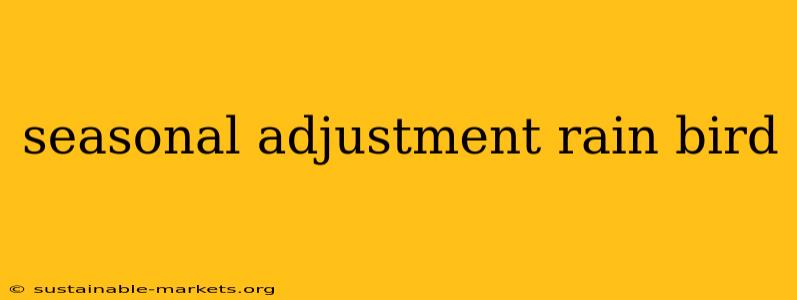Rain Bird irrigation systems are known for their reliability and efficiency. However, to maximize their performance and conserve water, seasonal adjustments are crucial. This guide provides a comprehensive overview of how to effectively adjust your Rain Bird system for optimal performance throughout the year. Understanding seasonal changes in weather patterns and plant water needs is key to achieving a healthy, thriving landscape while minimizing water waste.
Understanding the Need for Seasonal Adjustment
Your lawn's water requirements fluctuate significantly throughout the year. During the hot, dry summer months, your plants need considerably more water than during the cooler, wetter months of spring and fall. Failing to adjust your Rain Bird sprinkler system accordingly can lead to:
- Overwatering: This wastes water, can lead to root rot, and encourages fungal diseases.
- Underwatering: This stresses your plants, leading to brown patches, reduced growth, and increased vulnerability to pests and diseases.
- Uneven growth: Inconsistent watering leads to patchy lawns and gardens.
Key Factors Affecting Seasonal Adjustment
Several factors influence the necessary adjustments to your Rain Bird system:
1. Temperature:
Higher temperatures accelerate evaporation, increasing the demand for water. Adjust your watering schedule and duration to compensate for increased evaporation rates during hotter months.
2. Rainfall:
Periods of significant rainfall reduce the need for supplemental irrigation. Monitor rainfall amounts and adjust your system accordingly, potentially skipping scheduled watering cycles.
3. Sunlight:
Intense sunlight increases evapotranspiration (water loss from soil and plants). Longer days and stronger sunlight during summer require more frequent watering.
4. Plant Type & Growth Stage:
Different plants have varying water needs. Newly planted vegetation requires more frequent watering than established plants. Adjust watering schedules based on the specific water needs of your plants.
Adjusting Your Rain Bird System: A Step-by-Step Guide
Rain Bird offers several methods for seasonal adjustments, depending on your controller model:
1. Manual Adjustment:
This involves directly modifying the watering duration or frequency on your Rain Bird controller. Most controllers have a simple interface allowing you to increase or decrease watering times for each zone based on seasonal needs.
2. Seasonal Programs:
Many Rain Bird controllers offer multiple programs, allowing you to create separate schedules for different seasons (e.g., Spring, Summer, Fall, Winter). This allows for significant flexibility and precise control over watering. This is generally the recommended method for optimal water conservation.
3. Smart Irrigation Controllers:
Rain Bird's smart irrigation controllers use weather data (often via a connection to a weather station or app) to automatically adjust your watering schedule. This sophisticated approach minimizes water waste by dynamically responding to changing weather conditions.
4. Adjusting Individual Zones:
Consider the unique needs of different areas in your landscape. A sunny flowerbed will likely require more frequent watering than a shady lawn. Adjust the watering duration for individual zones to address these differences.
Tips for Optimal Seasonal Adjustment
- Monitor your lawn and plants regularly: Observe for signs of overwatering or underwatering, adjusting your system as needed.
- Use a soil moisture meter: This tool provides an accurate assessment of soil moisture levels, helping you determine when and how much to water.
- Consider using rain sensors: These sensors automatically suspend irrigation when sufficient rainfall is detected, saving water and preventing overwatering.
- Consult a professional: For complex irrigation systems or if you're unsure how to make adjustments, seek assistance from a qualified irrigation technician.
By following these guidelines and employing the appropriate Rain Bird seasonal adjustment methods, you can ensure your landscape thrives while conserving precious water resources. Remember, a well-maintained and seasonally adjusted irrigation system translates to a healthier, more beautiful, and more sustainable landscape.

